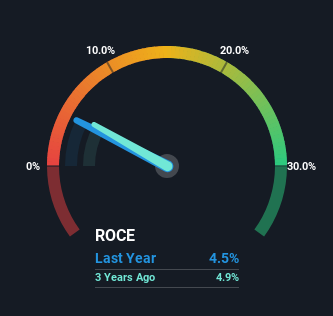- Hong Kong
- /
- Oil and Gas
- /
- SEHK:689
EPI (Holdings) (HKG:689) Is Doing The Right Things To Multiply Its Share Price
What are the early trends we should look for to identify a stock that could multiply in value over the long term? In a perfect world, we'd like to see a company investing more capital into its business and ideally the returns earned from that capital are also increasing. Ultimately, this demonstrates that it's a business that is reinvesting profits at increasing rates of return. With that in mind, we've noticed some promising trends at EPI (Holdings) (HKG:689) so let's look a bit deeper.
Return On Capital Employed (ROCE): What Is It?
For those that aren't sure what ROCE is, it measures the amount of pre-tax profits a company can generate from the capital employed in its business. To calculate this metric for EPI (Holdings), this is the formula:
Return on Capital Employed = Earnings Before Interest and Tax (EBIT) ÷ (Total Assets - Current Liabilities)
0.045 = HK$19m ÷ (HK$437m - HK$5.9m) (Based on the trailing twelve months to June 2024).
Therefore, EPI (Holdings) has an ROCE of 4.5%. Ultimately, that's a low return and it under-performs the Oil and Gas industry average of 6.2%.
View our latest analysis for EPI (Holdings)

Historical performance is a great place to start when researching a stock so above you can see the gauge for EPI (Holdings)'s ROCE against it's prior returns. If you'd like to look at how EPI (Holdings) has performed in the past in other metrics, you can view this free graph of EPI (Holdings)'s past earnings, revenue and cash flow.
What Can We Tell From EPI (Holdings)'s ROCE Trend?
We're delighted to see that EPI (Holdings) is reaping rewards from its investments and has now broken into profitability. While the business is profitable now, it used to be incurring losses on invested capital five years ago. Additionally, the business is utilizing 21% less capital than it was five years ago, and taken at face value, that can mean the company needs less funds at work to get a return. The reduction could indicate that the company is selling some assets, and considering returns are up, they appear to be selling the right ones.
The Bottom Line On EPI (Holdings)'s ROCE
In summary, it's great to see that EPI (Holdings) has been able to turn things around and earn higher returns on lower amounts of capital. And since the stock has dived 84% over the last five years, there may be other factors affecting the company's prospects. Still, it's worth doing some further research to see if the trends will continue into the future.
On a separate note, we've found 2 warning signs for EPI (Holdings) you'll probably want to know about.
For those who like to invest in solid companies, check out this free list of companies with solid balance sheets and high returns on equity.
Valuation is complex, but we're here to simplify it.
Discover if EPI (Holdings) might be undervalued or overvalued with our detailed analysis, featuring fair value estimates, potential risks, dividends, insider trades, and its financial condition.
Access Free AnalysisHave feedback on this article? Concerned about the content? Get in touch with us directly. Alternatively, email editorial-team (at) simplywallst.com.
This article by Simply Wall St is general in nature. We provide commentary based on historical data and analyst forecasts only using an unbiased methodology and our articles are not intended to be financial advice. It does not constitute a recommendation to buy or sell any stock, and does not take account of your objectives, or your financial situation. We aim to bring you long-term focused analysis driven by fundamental data. Note that our analysis may not factor in the latest price-sensitive company announcements or qualitative material. Simply Wall St has no position in any stocks mentioned.
About SEHK:689
EPI (Holdings)
An investment holding company, primarily engages in the exploration and production of petroleum in Canada and Hong Kong.
Flawless balance sheet with solid track record.
Market Insights
Community Narratives



